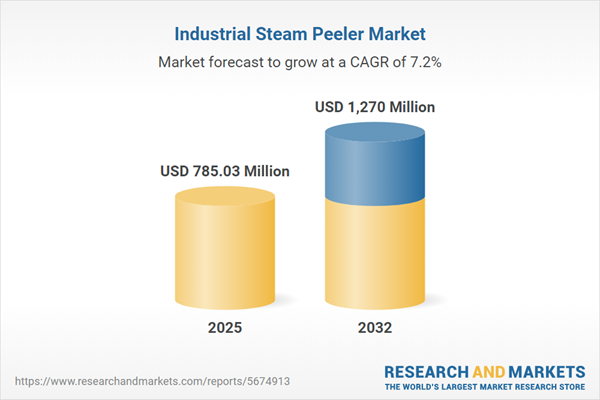Speak directly to the analyst to clarify any post sales queries you may have.
Senior decision-makers in regulated manufacturing industries are increasingly prioritizing the adoption of advanced industrial steam peeler solutions to enhance operational agility, ensure compliance, and maintain a competitive edge. By leveraging technological innovation and strategic sourcing, organizations can address complex challenges and strengthen their manufacturing processes in dynamic markets.
Market Snapshot: Industrial Steam Peeler Market
The industrial steam peeler market is on an upward growth trajectory, with global valuations rising from USD 731.13 million in 2024 to USD 785.03 million in 2025, and expected to achieve USD 1.27 billion by 2032, reflecting a robust 7.21% CAGR.
Key drivers include the widespread integration of automation and digital technologies that align with sustainability imperatives. Enterprises operating in tightly regulated sectors are investing in advanced steam peeler systems to navigate stringent compliance mandates, boost consistency, and build resilient supply chains. These technologies are now integral to sustaining manufacturing competitiveness across increasingly complex and evolving industry landscapes.Scope & Segmentation
- End User Industries: Chemical manufacturers require tailored systems supporting precision and customizable outputs. Food, bakery, produce, meat, and poultry producers depend on steam peeling for high hygiene and food safety. Pharmaceutical companies rely on steam technology to meet strict process compliance and regulatory benchmarks.
- Equipment Types: Batch system configurations allow flexible and responsive workflows for diverse production needs. Standard model machines address traditional industrial requirements. Modular platforms enable straightforward upscaling or downsizing based on changing production volumes and demand patterns.
- Operation Modes: Fully automated equipment, incorporating AI and digital controls, maximizes productivity and reliability. Semi-automatic steam peelers employ electric and pneumatic components for mid-sized operations. Manual models deliver reliable performance for site-specific and mobile deployments.
- Technologies: Energy recovery systems lower ongoing operational costs and support organizational sustainability goals. Industrial IoT features deliver real-time monitoring, leading to enhanced decision-making and process optimization. Adjustable throughput options enable facilities to balance production capacity with efficient energy use.
- Sales Channels: Direct procurement from original equipment manufacturers, partnerships with regional distributors, and OEM arrangements help organizations customize procurement and private-label strategies, aligning purchasing with evolving operational needs.
- Regions Covered: Solutions are tailored for the specific regulatory standards and infrastructure requirements of the Americas, Europe, Middle East & Africa, and Asia-Pacific. This localization ensures compliance and strategic deployment that align with local conditions.
- Company Analysis: Leading vendors comprise JBT Corporation, GEA Group Aktiengesellschaft, Marel hf., Bühler AG, Heat and Control, Inc., Key Technology, Inc., Weber Maschinenbau GmbH, Sormac B.V., Koenig Maschinen GmbH, and Urschel Laboratories, Inc.
Key Takeaways
- Advanced steam peeler systems bolster high hygiene levels and consistent output, benefitting sectors with strict regulatory controls.
- Real-time digital asset monitoring allows for proactive equipment maintenance and extends operational uptime.
- Flexible machine configurations accommodate evolving supply chain strategies and sustainability initiatives, meeting operational goals under rapidly changing conditions.
- IoT integration supports centralized data management and enhances executive oversight across multi-site manufacturing environments, improving resource allocation and visibility.
- The presence of comprehensive technical support and robust supplier partnerships streamlines the sourcing process and reduces risk during unpredictable market shifts.
- Varied levels of automation adoption, particularly prevalent in the Asia-Pacific region, are influencing manufacturers’ global sourcing, investment planning, and operational approaches.
Tariff Impact: Navigating Cost Structures and New Trade Dynamics
With recent U.S. tariff adjustments, manufacturers place increased emphasis on local equipment sourcing and improved logistics as critical cost-management levers. These changes in trade policy are compelling organizations to revisit procurement strategies to ensure operational and financial resilience in shifting global markets.
Methodology & Data Sources
Insights in this report are built upon direct interviews with industry leaders and technical experts, supported by primary field research. All data have been cross-verified with established industry benchmarks and regulatory standards to provide senior executives with credible, actionable findings for strategic planning.
Why This Report Matters
- Empowers leadership teams to align procurement, investment, and technology adoption with sustainable growth and resilience objectives.
- Presents a clear perspective on how digitalization, evolving regulations, and regional market differences affect procurement decisions and operational outcomes.
- Equips executives to identify emerging risks and capitalize on new opportunities, fostering agile responses to fast-changing business environments.
Conclusion
By adopting flexible steam peeler solutions and fostering strong supplier networks, organizations can address changing manufacturing needs, protect continuity, and retain a competitive position in global markets.
Additional Product Information:
- Purchase of this report includes 1 year online access with quarterly updates.
- This report can be updated on request. Please contact our Customer Experience team using the Ask a Question widget on our website.
Table of Contents
3. Executive Summary
4. Market Overview
7. Cumulative Impact of Artificial Intelligence 2025
Companies Mentioned
The companies profiled in this Industrial Steam Peeler market report include:- JBT Corporation
- GEA Group Aktiengesellschaft
- Marel hf.
- Bühler AG
- Heat and Control, Inc.
- Key Technology, Inc.
- Weber Maschinenbau GmbH
- Sormac B.V.
- Koenig Maschinen GmbH
- Urschel Laboratories, Inc.
Table Information
| Report Attribute | Details |
|---|---|
| No. of Pages | 181 |
| Published | October 2025 |
| Forecast Period | 2025 - 2032 |
| Estimated Market Value ( USD | $ 785.03 Million |
| Forecasted Market Value ( USD | $ 1270 Million |
| Compound Annual Growth Rate | 7.2% |
| Regions Covered | Global |
| No. of Companies Mentioned | 11 |









